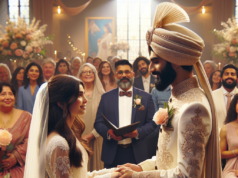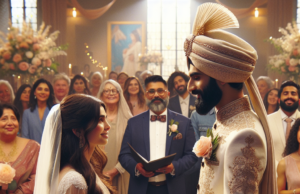
Laws Regarding Ohio Common Law Marriage
What is Common Law Marriage?
According to the NCSL, the National Conference of State Legislatures, a common-law marriage in Ohio requires “a positive mutual agreement, permanent and exclusive of all others, to enter into a marriage relationship, cohabitation sufficient to warrant a fulfillment of necessary of man and wife, and an assumption of marital duties and obligations.”
In other words, common law marriages in Ohio that still have validity involve a couple that agrees they are married, still live together and present themselves in public as husband and wife. In this article, a more thorough analysis of common law marriages in Ohio is discussed, as well as regular marriage requirements in the state.
Common-Law Marriage in Ohio
Common law marriages in Ohio no longer hold validity unless the common law marriage happened before a certain date. Ohio is one of five states that have grandfathered the common law marriage of some couple, and there are many laws that address a common law marriage in Ohio.
Code 3105.12 Proof of marriage mainly addresses common-law marriages in Ohio, and some of these laws under the Ohio Revised Code are paraphrased below:
(B) A common law marriage in Ohio is prohibited after October 10, 1991, and any marriage that is subsequently solemnized after this date must adhere to Chapter 3101 of the Ohio Revised Code.
(B)(2) “Common law marriage that occurred in this state prior to October 10, 1991, and that has not been terminated by death, divorce, dissolution of marriage, or annulment remain valid on and after October 10, 1991.”
(B)(3)(a) The common law marriage in Ohio was established prior to October 10, 1991, or was established on or after that date in another state or nation that recognizes common-law marriages as valid.
(B)(3)(b) The common law marriage in another state or nation has not been determined as invalid.
Marriage Requirements in Ohio
Ohio law on marriage is fairly simple compared to rules regarding common law marriage. Additionally, a common-law marriage in Ohio is only valid if the form of matrimony adheres to all conditions set forth in Code 3101.
In order for the marriage or grandfathered common law marriage in Ohio to hold legal validity, the marriage must have been entered into between a female that was at least 16 years old and a male that was at least 18 years old.
They may not relate to each other nearer than second cousins, and a legal marriage may only be entered into by one man and woman who are in no other marriage.
If a minor wants to marry, they should first obtain consent from their parents, a surviving parent, a parent who represents a residential parent or legal custodian, a guardian, or any of the following entities:
• An adult person
• The department of job and family services or a child welfare organization
• A public children services agency
Common Law Marriage Ohio: The Lowdown on Cohabitation in the Buckeye State
In many parts of the United States, couples who live together for a certain length of time are considered to be in a “”common law marriage.”” Common law marriages are not created by a ceremony or license; instead, they are formed by the couple’s actions and intentions. This can be a somewhat confusing and nebulous concept, and it is especially so in the state of Ohio. In this article, we’ll explore the ins and outs of Ohio common law marriage, including its history, how it works today, and what you need to know if you’re living with a partner in the Buckeye State.
A Brief History of Ohio Common Law Marriage
The idea of common law marriage dates back to medieval England, when many couples lived together without the benefit of a church-sanctioned marriage. Over time, courts began to recognize that couples who lived together for a long period of time and held themselves out as married should be treated as such, even if they didn’t have a formal certificate or ceremony to prove it.
In the United States, most states adopted some form of common law marriage recognition in the 19th or early 20th centuries. However, over time, many states began to roll back or abolish common law marriage recognition, usually due to changes in societal norms and legal frameworks. Today, only a handful of states still recognize common law marriage, Ohio among them.
What Is a Common Law Marriage in Ohio?
In Ohio, common law marriage is defined as a relationship between two people who are not married but who have lived together for a certain period of time and hold themselves out as a married couple. According to Ohio Revised Code section 3105.12, a common law marriage can be established in the following ways:
– The couple cohabitated (lived together) continuously for a period of time.
– The couple held themselves out as being married, either through their actions or verbal agreements.
– The couple intended to be married.
Note that none of these criteria require a formal ceremony or marriage license. Instead, common law marriage is based on the couple’s behavior and intentions.
How Long Does It Take to Form a Common Law Marriage in Ohio?
Ohio law does not specify a set period of time that a couple must live together in order to establish a common law marriage. Instead, the court will consider factors such as the couple’s actions, intentions, and relationship history when determining whether a common law marriage exists.
However, most legal experts agree that a common law marriage in Ohio is likely to be recognized after the couple has been living together for at least a year. This does not mean that a couple cannot establish a common law marriage in a shorter period of time, but it may be more difficult to prove the existence of the relationship in court.
How Does a Common Law Marriage in Ohio Work?
If a couple is deemed to be in a common law marriage in Ohio, they will have the same legal rights and obligations as a couple who were married through a formal ceremony and license. This means that they can generally:
– Share property and assets equally
– Be considered each other’s next of kin
– File joint tax returns (if they meet the IRS’s requirements for common law marriage)
– Have access to certain benefits and protections that are only available to married couples
However, it’s important to note that a common law marriage does not offer all of the same rights and protections as a formal marriage. For example, under Ohio law, common law spouses do not have the right to “divorce” or dissolve their relationship through the court system. Instead, they must separate informally or through an alternative dispute resolution process (such as mediation).
Additionally, if one partner dies without a will, the surviving partner may not automatically inherit their assets. If the couple did not make appropriate estate planning arrangements, the deceased partner’s assets will be distributed according to Ohio’s intestacy laws, which may not align with their wishes.
How Do You Prove a Common Law Marriage in Ohio?
If you believe that you are in a common law marriage in Ohio and need to prove its existence, there are several factors that can be used to support your case:
– Testimony from witnesses who knew the couple and can verify their behavior and intentions
– Joint bills, bank accounts, or other documentation that shows the couple shared expenses and assets
– Letters, emails, or other written communication between the couple that suggests they considered themselves to be married
– Statements from the couple themselves describing their relationship as a marriage
It’s important to note that proving a common law marriage in Ohio can be a difficult and complicated process, particularly if one partner denies the existence of the relationship. If you believe that you are in a common law marriage and need to establish its validity, it’s important to consult with an experienced family law attorney who can help guide you through the process.
The Future of Common Law Marriage in Ohio
Even though Ohio still recognizes common law marriage, it’s worth noting that the legal and social landscape is rapidly changing. As more and more couples choose not to get married or delay marriage until later in life, the need for legal recognition and protections for cohabitating couples is becoming increasingly urgent.
However, at the same time, conservative politicians and interest groups are pushing back against efforts to expand legal recognition for non-traditional relationships. For example, in 2017, Ohio lawmakers introduced a bill that would have abolished common law marriage recognition in the state. Although the bill did not pass, it’s clear that the issue is far from settled.
If you’re living with a partner in Ohio and considering your legal options, it’s important to research all of your options carefully and consult with an experienced attorney. Whether you choose to pursue a common law marriage or other forms of legal recognition, understanding your rights and responsibilities is essential for protecting yourself and your loved ones.




















